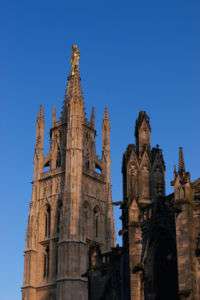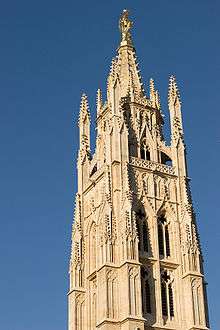Bordeaux Cathedral
| Bordeaux Cathedral Cathédrale Saint-André | |
|---|---|
 The north front of the cathedral | |
| Basic information | |
| Location |
Bordeaux, France |
| Geographic coordinates | 44°50′16″N 0°34′39″W / 44.83778°N 0.57750°WCoordinates: 44°50′16″N 0°34′39″W / 44.83778°N 0.57750°W |
| Affiliation | Roman Catholic Church |
| Rite | Roman |
| District | Archdiocese of Bordeaux |
| Ecclesiastical or organizational status | Cathedral |
| Architectural description | |
| Architectural type | Church |
| Architectural style | Gothic, Romanesque |
The Cathedral of Saint Andrew of Bordeaux (French: Cathédrale Saint-André de Bordeaux), commonly known as Bordeaux Cathedral, is a Roman Catholic church dedicated to Saint Andrew and located in Bordeaux, France. It is the seat of the Archbishop of Bordeaux.
History and description
The cathedral was consecrated by Pope Urban II in 1096. Of the original Romanesque edifice, only a wall in the nave remains. The Royal Gate is from the early 13th century, while the rest of the construction is mostly from the 14th-15th centuries. The building is a national monument of France.
In this church in 1137 the 13-year-old Eleanor of Aquitaine married the future Louis VII, a few months before she became Queen.
A separate bell tower, the Tour Pey-Berland, stands next to the cathedral.
The site is served by line A and line B of the tramway de Bordeaux at Station Hôtel de Ville.
Marcadé collection
The cathedral is home to the Marcadé collection, which consists of a group of forty-two illuminations, among other objects (paintings, sculptures, liturgical vestments and silver objects). It was given to Bordeaux Cathedral by Canon Marcadé in 1947. Of note, these illuminations, little studied so far, will be exhibited starting in 2015 in the cathedral, in a room specially designed for this collection. [1]
Gallery
- Door of Arrows (Portail des Flèches) of Bordeaux Cathedral
 Detail of the Door of Arrows (Portail des Flèches)
Detail of the Door of Arrows (Portail des Flèches) North rose window
North rose window Royal portal (Portail royal)
Royal portal (Portail royal) Gargoyles
Gargoyles Pey-Berland tower next to the cathedral
Pey-Berland tower next to the cathedral- St Augustine, St Blaise and St Macarius
 Interior view
Interior view- Choir
 The Grand Organ
The Grand Organ Pey-Berland tower (northeast view)
Pey-Berland tower (northeast view) Top of the tower (southeast view)
Top of the tower (southeast view) Pey-Berland tower (east view)
Pey-Berland tower (east view)- Front view of the cathedral
- Interior view with huge pipe organ
- Decorative grille
- Ceiling
 Back view
Back view
See also
References
- Article incorporates text licensed under the CC-by license from Heritage Science as cited
- ↑ Mounier, Aurélie; et al. (October 24, 2014). "Hyperspectral imaging, spectrofluorimetry, FORS and XRF for the non-invasive study of medieval miniatures materials". Heritage Science. Springer. 2 (24). doi:10.1186/s40494-014-0024-z. Retrieved 1 March 2015.
External links
| Wikimedia Commons has media related to Bordeaux Cathedral. |